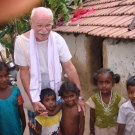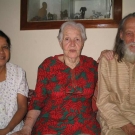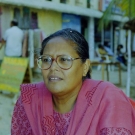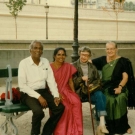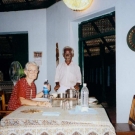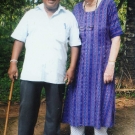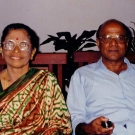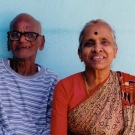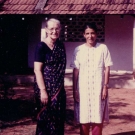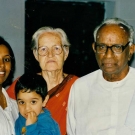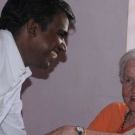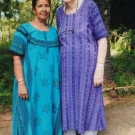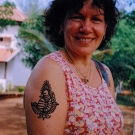To discribe Claire’s family in India, it is difficult to know where to start as it is so vast and diverse : colleagues with whom she developed friendships, those around her in her daily life when she was in Polambakkam, her adoptive family, but also friends she enjoyed meeting regularly to share difficulties and joys, and also to gain from their experience and advice. Of course you should not see any precedence in the order in which we introduce those “family members” : everyone on its own way was important in Claire’s eyes. And for all those not yet listed on this page, please forgive us — we were not with Claire permanently — and help us to repair these oversights.
Let’s start with the one already mentioned in her AFI-ICA family : Nalini Nayak. Similarly to Claire, she was 18 when she joined the AFI-ICA team to work in Marianad (Kerala), “quite certain that I wanted to dedicate my life to a Christian’s witness among the poor. We were constantly challenged in the student movement about our responsibility to the less privileged and in creating a truly free India post independence”. Born in Bangalore, Nalini studied social sciences. She was active in the movement of fishworkers, in Kerala and then internationally, and she still works in SEWA (Self Employed Women’s Association), the first union of women in the unorganised sector (domestic work, crafts, fisheries, baskets, etc. .). Nalini took a temporary commitment of a few years in the AFI-ICA group, but then she did not renew her membership while continuing to work with some AFI-ICA members and keping friendly relations with all AFI-ICA members in India. Claire loved to spend a few days in her house in Trivandrum and Nalini was her confidant in all her difficulties, including when she had to decide to return to Belgium or not.
Testimony of Nalini
The Little Brothers of Jesus (Charles de Foucauld) were also close to Claire. Michael, Arul and Shanti (the first two from France, the third one from Belgium) had worked among the Tamils in Sri Lanka, and as they knew already the local language they expect to find some work in Tamil Nadu. Working visas were difficult to obtain for foreigners at the time, but the work for leprosy could be a possibility (as was the case for Jacques and Francine). Thanks to Prof. T.N. Jagadisan (+) — an university professor who had contracted leprosy, and a great friend of Claire too — the Little Brothers were appointed as paramedical workers at Malavanthangal, another center for leprosy control in the region. They got their training in Polambakkam (1964) and settled in Alampoondi, a small village near Thiruvanamalai. Besides their special care for the leprosy patients in their area, they gradually developed several activities with the villagers : a center for the disabled, weavers cooperative, herbal medicine, etc. Arul had to return to France for health reasons, while Michael and Shanti have since long acquired Indian citizenship and now retired, they live in Bangalore for one and in Vellore for the second. For many years, the house in Alampoondi has been welcoming several foreign visitors, eager to learn about life in the villages. Claire loved to share the prayer of the Little Brothers in their chapel, and considered Michael and Shanti privileged confidants.
Reflections from Michael
Dr. Hemerijckx had passed his love of India on one of his son, Piet, who had joined the Jesuits and wanted to work with the Belgian Jesuits who held several highly reputed colleges in Bihar. He was obviously denied a visa, but the doctor — then WHO consultant to the Indian government — wrote in essence : “You want the father to work with you but you refuse the son, what would I look like if I tell that in my country ?” … And the visa was granted ! (1964) Piet would quickly feel the Jesuit environment too “narrow” for him, he left the congregation, and settled in poor neighborhoods, while continuing the study of Hindi, Sanskrit and religious texts. He worked with various Indian institutes to publish translations of several religious books, convinced that all religions could be a “bridge” for all believers to meet and live in harmony. When he got his Indian citizenship, he changed his name to Shilanand Hemraj, later on he married with Kavari, a young woman from Bangalore, where they currently live, both involved in social projects. He considered Claire as his “elder sister” and came regularly to visit her in Polambakkam. Sudeepta, the daughter of Shilanand and Kavari, made lot of efforts to study medicine “to follow the example of ‘Aunty Claire’ !”
Loving tribute to Dr. Claire Vellut
The friends of Polambakkam
When Claire got Indian citizenship (1979), she felt she was becoming a little more “Indian among the Indians” — a long awaited wish — and she could live in India until the end of her life. Friendly relations had developed with the family of Leo Alex, one of her colleagues — he was supervising the paramedical workers posted in the region of Polambakkam and often helped Claire in the problems that could occur with the staff of the Centre. One of his daughters, Isha, stayed with Francine and Jacques hoping to study in Belgium. With Clara (+) and Alex (+), and their seven children, Claire thought they could live together in their old age, and in 1980 they bought a house together in Chingleput. Unfortunately Alex passed away in 1992, but Chingleput remained Claire’s “home” until Clara also died in 2008. The seven children of Clara and Alex remained very attached to their “Auntie” and Claire continued to take part in the joys and family celebrations, particularly when staying with Asha in Madras.
Claire has been working with a lot of medical staff, first during 25 years in Polambakkam — when we look with Claire at group photos taken on occasion of the royal visits, we still manage to mention all their names ! — and then as “Secretary of the Damien Foundation” or when creating new projects in the North. Let us mention a few in particular.
P. Antony, a physiotherapist, who was also of the first team with Hemerijckx. Very skilled in his work, Antony had the opportunity to specialize in Canada, but he preferred to continue his work “in the field” with leprosy patients. His wife Bala (+) was also working at the Centre as a nurse, and on retirement, they settled in Pondicherry where their house became a friendly pied-a-terre when Claire wanted to have a few moments of rest.
Sadagopan (+) was the chief-administrator of the Center. Suffering from leprosy, he had some disabilities on feet and hands, but it did not prevent him to unravel the mysteries of the governement administrative rules and to make accounts as prescribed by the State Treasury. Claire had full confidence in him. Upon retirement, he moved near Polambakkam with his wife Kokila — who was a teacher at the village school, and beautifully mastered Indian classical singing. Claire loved to visit them. Since the death of Sadagopan, Claire kept the same friendly relations with Kokila and children who still consider her “their own family”.
Letter from Sadagopan (1989)
Arul (+), well known to all visitors of Polambakkam as taking care of the kitchen ! Able to adapt the Indian cuisine to sometimes fragile European stomachs, all in the simplicity of what is found locally, he has been taking care of Claire for over 40 years (?). When he also passed away before Claire, his wife Saleth Mary and his stepdaughter continued faithfully to prepare the meal when Claire was Polambakkam.
V. Vedadri was for many years in charge of Anandapuram, the home for disabled patients 500m from the Center. He was one of the last from the initial staff to stay in Polambakkam until the departure of Claire. In recent years, whenever she could, Claire loved to spend some peaceful moments in Anandapuram, caring for the multiple ailments of the patients, and Vedadri thus became the “daily companion” of Claire, in addition to being already the “handyman” to solve all the small practical problems Claire would face.
A Belgian turned Indian
Cathy Pouchpadass, Franco-Indian doctor, who worked with Claire especially for the WHO-THELEP therapeutic studies in Polambakkam. She settled back in France but kept close contacts with Claire.
Cathy remembers
Last but not least, we should mention all the doctors and other staff of the Damien Foundation India (some of them are less well known to us). Knowing that we could not be exhaustive, however, we wish to mention the Dr. Kandaswamy (+), Bakhta Reddy, Krisnamurthy, Shivakumar (who was at the funeral to represent all), Anne Mattam (the only woman doctor ! in the North), … and all the others. Among the administrative staff, Pamela Rao — which began as an administrative secretary in the Madras office — obviously deserves a special mention, since she came to study in Belgium, she married and was therefore closer to the Vellut family.
Living in Polambakkam but without any professional connection, we want to mention Mr Muttumalla Reddiar (+) and his family. Major landowner of the village, he had given the land on which were built the Centre and staff quarters. He was an important moral support for Claire and with his wife, they were great hosts for friends or VIPs Claire received. And today his children continue the same tradition.
As she was “retired” and spent more time in Polambakkam, Claire was very interested in the work of Father John Suresh. In addition to being the parish priest, Father Suresh responsibilities included a large school (primary, secondary and technical) in Neerpair, a few kilometers away, the vast majority of students being dalits. And Claire was well aware that the best way for these young people to get out of their status as “outsiders” was to acquire a good education. She had also invited his friends to financially support the activities of Father Suresh .
Tribute by Father Suresh
Friends outside Polambakkam
Well before leaving Polambakkam (1980) and extending her responsibilities to other leprosy centers, Claire had developed a special friendship with two other project managers. Dr. Yvette Tiphagne (+ 1999) was in charge of a leprosy unit in Arisipalayam (Salem). Coming from France before the last war, she never returned to her native country and she had been adopting — over the years — 6 orphans of different Indian families. If Yvette and Claire had met to share their professional experiences in the field of leprosy, their relationship grew much beyond. Although she did not belong to AFI, Yvette loved attending meetings and retreats organized by AFI, and sometimes she was accompanied by her children. Thus, one of her son, Henri, now engaged in an association for human rights, remembers.
Testimony of Henri Tiphagne
While the Polambakkam Centre regularly received requests to expand its work to new villages, an arrangement with the Foreign Missions Sisters in Pondicherry made possible to start a new service in Rawtakuppam, in a region adjacent to the area Polambakkam area. Sister Mary Regina (+) took the responsibility of that unit for many years (she died in at the age of 102 !). The staff was trained in Polambakkam and Claire came regularly to support the team in Rawtakuppam, which also took afterwards the name “Hemerijckx Rural Centre”.
It is nice to recall that we, Jacques and Francine, we have been working with all these people, we shared many concerns and joys, and we feel they are also part of “our family of India” today.
On the other hand, we want to mention a few people who are less known to us, but we know they were dear to the heart of Claire who would visit them whenever possible.
Alina Cattani (+) and Hildegard Sina (+), both AFI, both medical doctors, one Italian and the other German. Both of them had created and worked in the small hospital of Mitraniketan in the mountains of Kerala, for the benefit of workers in tea plantations. The hospital is located near the Kurusimala Ashram, a Cistercian monastery of the Syro– Malankara Catholic rite founded by a cousin of Claire, Father Francis Mahieu (of Scourmont) known as Francis Acharya, and where Claire went several times for moments of prayer and contemplation.
Christine de Severy, a lab technician who lived in Kumbakonam, from Switzerland;
Sr Muriel, of Mogapair (Chennai), with whom Claire had tried to approach alternative medicine.
We wish to complete the list of the great “Indian family” by two people who are not Indian and do not live in India, even if their visits to Polambakkam did initiate a deep friendship between them and Claire.
Denis von der Weid, Doctor of Laws from Switzerland. Denis met Claire in Polambakkam in the early 70s, while he was working with NGOs defending human rights in the region, which gave him the opportunity to return regularly thereafter. Claire greatly appreciated the information and sociopolitical analysis that Denis brought her about the problems of “marginalised people” in India and elsewhere in the world. And “the welcome extended by Claire was always a happiness of which the seeds bear fruit today”. (see also the Golden book)
And the very last person to be mentionned : Marie-Jo Colibeau. Osteopath, living in France, she also met Claire in Polambakkam. Claire — who had never been sick in her active life — had a total trust in her treatments with alternative methods, both for her body and mind, and when back to Europe Claire would make it a point to spend a few days with her. Thanks for her caring friendship.
